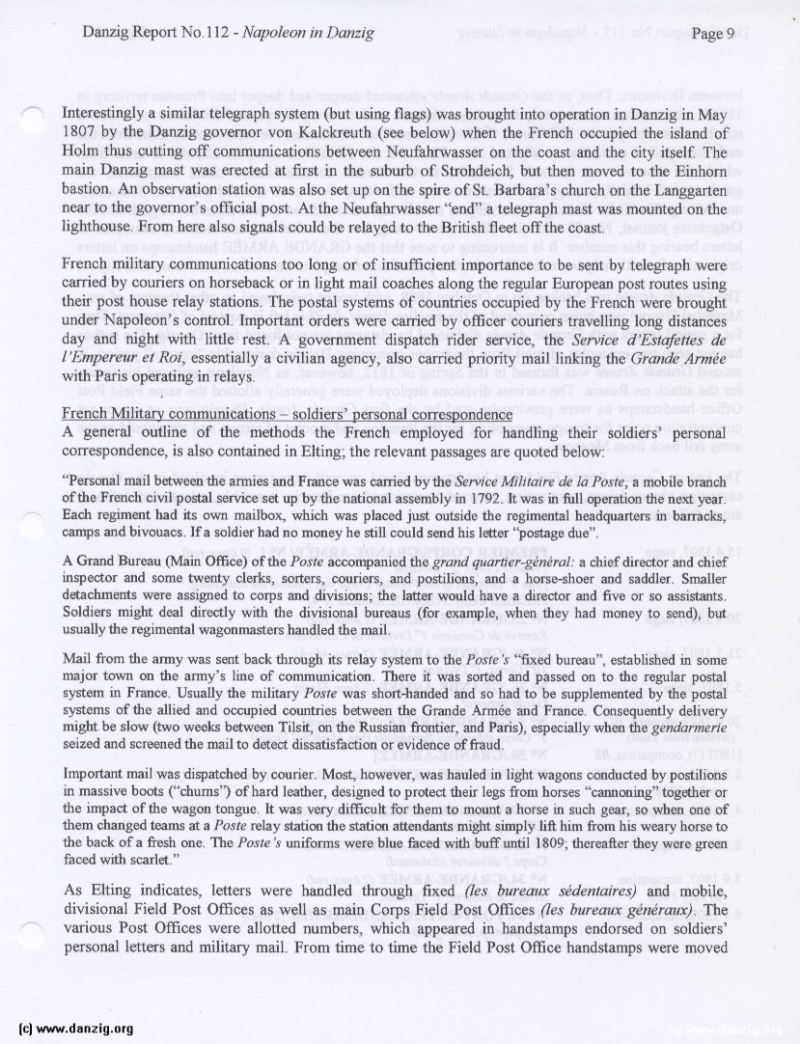
Interestingly a similar telegraph system (but using flags) was brought into operation in Danzig in May 1807 by the Danzig governor von Kalckreuth (see below) when the French occupied the island of Floim thus cutting off communications between Neufahrwasser on the coast and the city itself The main Danzig mast was erected at first in the suburb of Strohdeich, but then moved to the Einhorn bastion. An observation station was also set up on the spire of St. Barbara’s church on the Langgarten near to the governor’s official post. At the Neufahrwasser “end” a telegraph mast was mounted on the lighthouse From here also signals could be relayed to the British fleet off the coast
French military communications too long or of insufficient importance to be sent by telegraph were carried by couriers on horseback or in light mail coaches along the regular European post routes using their post house relay stations. The postal systems of countries occupied by the French were brought under Napoleon’s control Important orders were carried by officer couriers travelling long distances day and night with little rest. A government dispatch rider service, the Service dEsiafettes de l’Empereur el RoE, essentially a civilian agency, also carried priority mail linking the Grande Armée with Paris operating in relays
French Military_communications soldiers personal correspondence
A general outline of the methods the French employed for handling their soldiers’ personal correspondence, is also contained in Elting; the relevant passages are quoed below:
“Personal mail between the armies and France was camed by the Service Mihtaire ck la Poste, a mobile branch of the French civil postal service set up by the national assembly in 1792. It was ii full operation the next year Each regiment had its own mailbox, which was placed just outside the regimental headquarters in barracks, camps and bivouacs, If a soldier had no money he still could send his letter “postage due”.
A Grand Bureau (Main Office) of the Poste accompanied the grand quartier-génEral: a chief director and chief inspector and some twenty derks, sorters, couriers, and postilions, and a horse-shoer and saddler. Smaller detachments were assigned to corps and divisions; the later would have a director and five or so assistants. Soldiers might deal directly with the divisional bureaus (for example, when they had money to send), but usually the regimental wagonmasters handled the mail
Mail from the army was sent back through its relay system to the Porte r “fixed bureau”, established in some major town on the army’s line of communication. There it was sorted and passed on to the regular postal system in France. Usually the military Posire was short-handed and so had to be supplemented by the postal systems of the allied and occupied countries betwcon the Grande Arméc and France Consequently delivery might be slow (two weeks between Tilsit, on the Russian frontier, and Paris), especially when the gendarmerie seized and screened the mail to detect dissatisfaction or evidence of fraud.
Important mail was dispatched by courier. Most, however, was hauled in light wagons conducted by postilions in massive bcxts (“chums’) of hard leather, designed to protect their legs from horses “cannoning” together or the impact of the wagon tongue ft was very difficult for them to mount a horse in such gear, so when one of them changed teams at a Porte relay station the station attendants might simply hif him from his weary horse to the back of a fresh one, The Paste ‘.s uniforms were blue faced with buff until 1809; thereafter they were green faced with scarlet”
As Elting indicates, letters were handled through fixed (les hureaux sédenlaires) and mobile, divisional Field Post Offices as well as main Corps Field Post Offices (les hureaux génEraux). The various Post Offices were allotted numbers, which appeared in handstamps endorsed on soldiers’ personal letters and military mail. From time to time the Field Post Office handstamps were moved
Danzig Report Vol. 1 - Nr. 112 - July - August - September - 2001, Page 9.
Hits: 3173
Added: 30/07/2015
Copyright: 2024 Danzig.org

